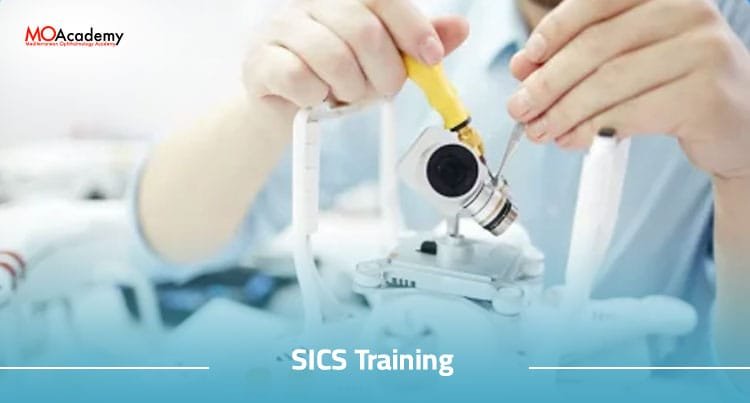SICS Training 2025
Why Learn Small Incision Cataract Surgery “SICS Training”?
Learning Small Incision Cataract Surgery (SICS training) is beneficial for numerous reasons.
First and foremost, SICS is a cost-effective and efficient method of treating cataracts,
especially in resource-limited settings.
It requires minimal instrumentation and has a short learning curve,
making it an accessible skill for ophthalmologists.
In addition, SICS has been demonstrated to have comparable, if not superior,
outcomes to phacoemulsification, especially in the management of mature and hard cataracts.
Therefore, mastering SICS can significantly enhance an ophthalmologist’s surgical repertoire.
Furthermore, SICS provides a viable alternative to phacoemulsification in situations
where the latter may not be suitable, such as in patients with a high risk of corneal endothelial damage,
or where the cataract is too dense for safe phacoemulsification.
SICS is also a great option in cases where there is a lack of access to phacoemulsification
equipment or when the cost of phacoemulsification consumables is prohibitive.
The ability to perform SICS can be a game-changer in an ophthalmologist’s practice,
particularly in developing countries where the need for cost-effective cataract surgeries is high.
By mastering this technique, ophthalmologists can provide quality eye care services
to a larger patient population, and contribute significantly to reducing the global burden of cataract blindness
How to Develop the Skills Needed for Successful Small-Incision Cataract Surgery
Small Incision Cataract Surgery (SICS) is a low-cost, suture-less, and efficient procedure
that requires a high level of skill and precision.
It is essential to develop the right skills to ensure the success of this procedure.
Understanding of the Procedure: The first step is to have a thorough understanding of the procedure,
including the anatomy of the eye, the nature of cataracts, and the specific steps involved in MSICS.
SICS Training or Hands-on Training: Practical hands-on training is crucial.
This includes practicing on simulators or cadaveric eyes before performing surgery on real patients.
Mentorship: Learning from experienced surgeons who can provide guidance, feedback,
and supervision is incredibly valuable. It allows for the development of skills in a safe and controlled environment.
Continuous Practice: Like any surgical procedure, consistency and regular practice
are key to mastering MSICS.
Regularly performing the procedure helps to improve speed, efficiency, and outcomes.
Learning from Complications: It’s essential to learn from any complications that arise during surgery.
This can provide important insights and practical knowledge that can be used to improve future surgeries.
Keeping Up-to-date: The field of ophthalmology is constantly evolving. Keeping up-to-date
with the latest research, techniques, and tools is essential for continuous skill development and improvement.
Patient Communication: Building good rapport with patients is an essential skill.
Understanding their concerns and explaining the procedure, risks,
and expected outcomes can help reduce their anxiety and gain their trust.
Teamwork: Efficiently coordinating with your surgical team can make the procedure smoother.
Clear communication and understanding of each team member’s role can significantly
improve the overall surgical experience.
Self-Care: It’s easy to overlook, but surgeons need to take care of their physical health as well.
Regular exercise, especially for the hands and eyes, can help maintain the sharpness of skills.
Adequate rest is also crucial to avoid fatigue during surgery.
Professional Development: Attending workshops, conferences, and other professional development
activities can provide opportunities to learn new techniques, understand emerging trends,
and network with other professionals in the field.
This can contribute significantly to improving one’s skills and knowledge.
Research and Innovation: Being open to new ideas and advancements can lead to better surgical
techniques and outcomes. Participating in research and contributing to scientific literature
can also enhance understanding and expertise in SICS.
Preparing for hands-on training in Small Incision Cataract Surgery (SICS) involves several key steps:
- Master the Theory: Before you begin hands-on training, you need to have a solid understanding
of the theory behind the procedure.
This includes understanding the anatomy of the eye, the nature of cataracts, and the specific steps involved in SICS. - Observe Experienced Surgeons: Observing experienced surgeons performing the procedure
can be incredibly insightful.
Try to find opportunities to shadow surgeons during SICS procedures. - Use Simulators: Simulators provide a risk-free environment to practice surgical techniques.
Make use of these tools to familiarize yourself with the procedure and to develop your skills. - Practice on Cadaveric Eyes: Once you feel comfortable with the simulator,
you can move on to practicing on cadaveric eyes.
This allows you to experience the procedure in a more realistic setting. - Learn from Mistakes: It’s important to reflect on any difficulties or mistakes you encounter
during your hands-on training.
Analyze what went wrong and how you can improve. - Seek Feedback: Don’t hesitate to ask for feedback from experienced surgeons or mentors.
Their insights can help you refine your technique and improve your skills. - Consistent Practice: The key to mastering SICS is consistent and regular practice.
The more you practice, the more comfortable you will become with the procedure.
Remember, hands-on training is a crucial part of learning SICS, but it should be supplemented
with theoretical learning, mentorship, and self-study.

